

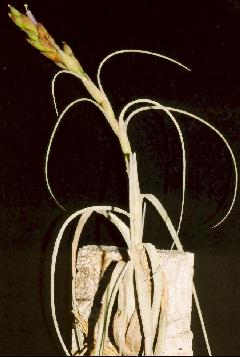
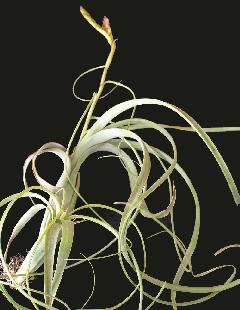
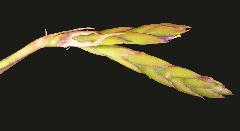

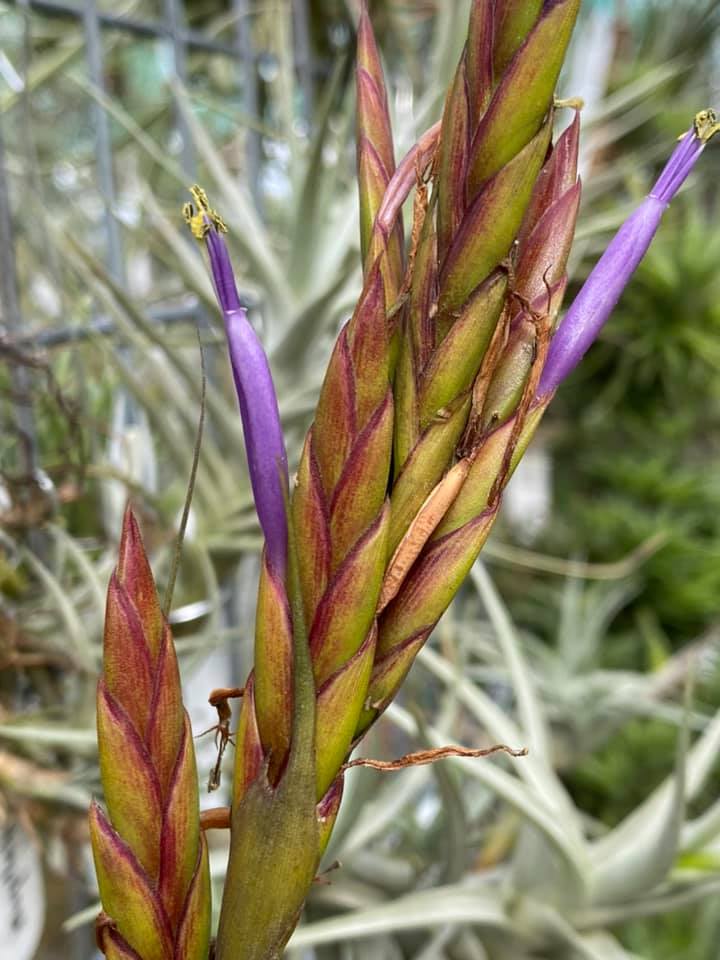

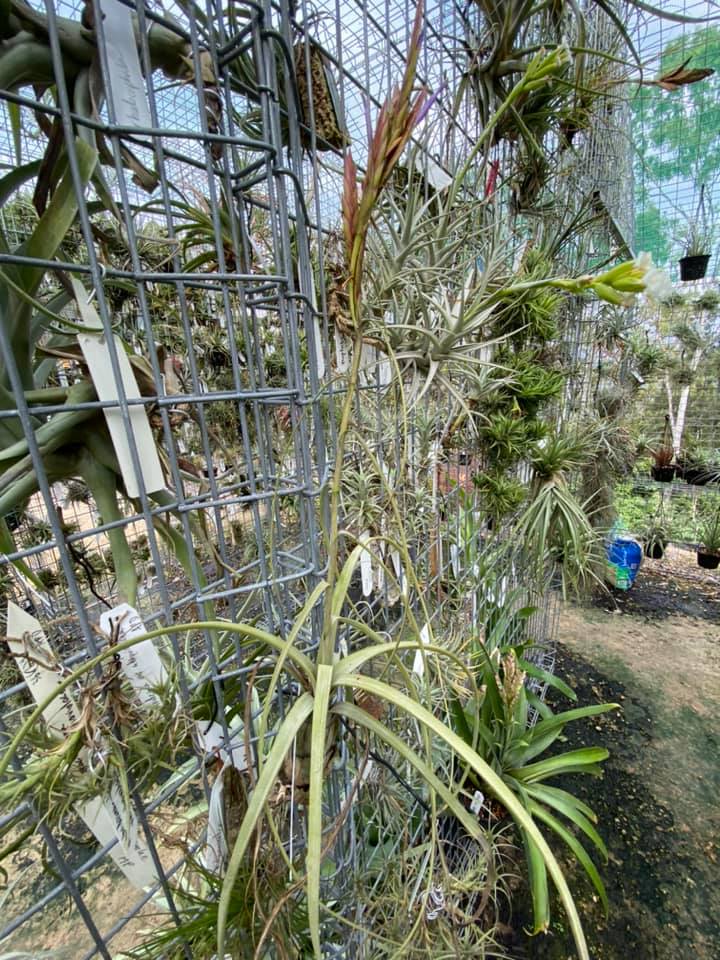
Tillandsia dressleri L. B. Smith, Phytologia 8: 221,pl. 1,fig. 7. 1962. treated as a synonym of T. balbisiana by Gardner 1982 Tillandsia PhD dissertation
T. disticha H B K in systema Mezii proxima sed bulbo elongata, foliorum laminis majoribus reflexis, sepalis subaequaliter liberis differ. A T. balbisiana Schult. Cujus habitu valde imitans, staminibus quam petalis brevioribus ( Subgen. Allardtia) differt
Plant stemless, flowering 35 cm high.
Leaves bulbous-rosulate, covered with minute subappressed cinereous scales;
Sheaths ovate, to 10 cm long, tightly clasping the scape and forming a narrowly ovoid bulb;
Blades strongly reflexed, very narrowly triangular , filiform-attenuate, to 55 cm long, 15 mm wide, involute toward apex.
Scape erect, soon glabrlus, sulcate when dry;
Scape-bracts densely imbricate and concealing the scape, subfoliaceous with small elliptic sheaths and elongate reflexed blades, very densely lepidote.
Inflorescence bipinnate, 12 cm long, subdigitate;
Primary bracts incompletely known but their sheaths shorter than the spikes, very densely lepidote;
Spikes divergent, oblong-lanceolate, 3-8 cm long, 15 mm wide, to 16-flowered, strongly complanate;
Rhachis flexuous, winged, sparsely and obscurely punctulate-lepidote.
Floral bracts densely imbricate but narrow and more or less exposing the rhachis, ovate, acute, to 18 mm long, much exceeding the sepals, sharply carinate, subcoriaceous, glabrous, lustrous;
Flowers subsessile.
Sepals equally subfree, oblong-lanceolate, broadly acute, 12 mm long, glabrous, nerved;
Petals blue-purple, the blades divergent, nearly 2 cm long, exceeding the stamens.
Type. Dressler s n (holotype MO), on trees, 8 miles south of Agua Nueva, Sinaloa, Mexico, 31 Dec 1949.
DISTRIBUTION. Known from the type collection only.
Detail from Baker 1889
149. T. URBANIANA Wittm. in Engl. Jahrb. xi. 65
Leaves densely rosulate, linear-setaceous, above a foot long, under an inch broad at the dilated base, the edges involute down nearly to the base. Peduncle much shorter than the leaves. Spikes 2, dense, distichous, ascending, 1½-2 in. long, ⅓ in. diam.; branch-bracts small; flower-bracts oblong-lanceolate, ½ in. long. Sepals as long as the flower-bract. Petals violet. Capsule cylindrical, three times the length of the calyx.
Hab. Costa Rica, near Cartago, alt. 5000 ft., Lehmann 1771. Near T. disticha H. B. K.
Detail from McVaugh in Flora Novo Galiciana 1989
Tillandsia balbisiana Schult. F. in Roem. & Schult. Syst. Veg. 7, pt. 2: 1212. 1830.
Lowlands of the Pacific slope, on trees in tropical deciduous or subdeciduous forest, 30-450 m, flowering Oct-May.
Sin., Nay., Jal., Col., Gro., Ver., S.L.P., Tamps., Tab., Yuc., Chis.; Centr. Amer.; s Fla.; W. Ind. (Jamaica, Bertero, "in hb. Balbis" {TO}, the holotype); S. Amer.
Ca 20 km NW of Tepic (Rzedowski 15595, ENCB, cited by Magana, not seen); San Blas (Ferris 5463); 32 km N of Puerto Vallarta (Gardner 1347!); Mpio. Cabo Corrientes (road to Ixtlahuahuey, Magana 377; 2 km S of El Tuito, Magana et al. 41; both MEXU, cited by Magana, not seen); {also cited by Magana, all at MEXU: 20 km NW of Chamela, Sousa 3928; Chamela, Estacion de Biologia (10 additional collections)}; 8 km E of Chamela, lands of Estacion de Biologia (McVaugh 25233, 25234, both det. by L. B. Smith, S. Gardner & J. Utley); hills near the pass 17-18 km SSW of Colima (McVaugh 24958, det. as above).
Plant. Acaulescent, up to 65 cm high in flower; leaves 10-15 or more, often longer than the inflorescence but typically recurved, densely pale-lepidote, often purplemargined; sheaths inflated, ovate to elliptic, 2-10 cm long, 1-4 cm wide, forming an ovoid or ellipsoid pseudobulb up to 12 cm long; blades abruptly spreading or recurving from the apices of the sheaths, linear-triangular, usually involute their whole length, filiform-attenuate, 10-60 cm long, ca 1 cm wide at base;
panicle erect or ascending, at least when young fusiform or subcylindric, up to 20 cm long, pinnately or somewhat digitately divided (rarely simple and distichous-flowered), the spikes 2-4 (-8), sessile, appressed, flattened, linear, acute, 3-12 cm long, 1 cm wide at anthesis;
scape (peduncle) slender, subglabrous, its bracts commonly pink or red, their sheaths imbricated, inflated, ellipsoid with long linear spreading to strongly reftexed blades;
primary bracts 1.5-7 cm long, shorter than the spikes;
floral bracts erect, imbricated, ovate, obtuse and apiculate (acute in profile), 12-22 mm long, exceeding the sepals, glabrous or nearly so and smooth and lustrous, sometimes slightly nerved toward apex, coriaceous, not keeled, commonly bright red;
flowers erect, subsessile;
sepals elliptic, obtuse or subacute, 10-14 mm long, coriaceous, smooth (not nerved), glabrous, the adaxial (posterior) ones connate;
petals tubular-erect, ligulate, subacute, 2-4.5 cm long, violet ("morados," "purple");
stamens and pistil exserted; stigma green, spiral;
fruit cylindric, 2-4 cm long, 3-4 mm in diameter;
seeds 60-90, 0.8-2 cm long.
From Gouda in Flora of the Guianas 1989
3. Tillandsia balbisiana Schultes filius in Roemer & Schultes, Syst. 7 (2): 1212. Type: Jamaica, Bertero s. n. (TO not seen).
Plant acaulescent, flowering 20-55 cm tall, with 8-15 somewhat cinereous-green leaves mostly exceeding the inflorescence, but often recurving, the sheaths forming a dense ovoid and cinereous pseudobulb.
Leaves about 10-20, rigid-coriaceous, (20-)30-50 cm long, mostly longer than the inflorescence;
sheaths distinct, contracted into the blades, ovate, greatly inflated-convex, 2.5-7.5 x 1.7-6 cm, with narrow thin margins, very densely (or obscurely) subappressed-lepidote and glabrous at the extreme base, pale-ferrugineously lepidote inside, often with a purple-red band at the margins;
blades strongly recurved, very narrowly triangular, often involute at the margins (at least when dry), 17-45 x 0.7-1.8 cm, filiform-attenuate, very densely (sub-) appressedlepidote throughout.
Inflorescence densely bipinnate of 2-6 spikes or simple, (4-)9-17 cm long;
scape erect, 13-30 cm long, ca. 4 mm in diam., glabrous, densely covered by bracts;
scape bracts imbricate, chartaceous, ovate, with foliaceous to filiform blade, excluding the blade exceeding the internodes, densely appressed-lepidote at both sides, except near the bases, cinereous;
axis mostly short, but partly exposed, almost straight, rugose when dry, glabrous;
primary bracts as the upper scape bracts, but more caudate, exceeding and hiding the sterile bases of the spikes;
spikes erect, subsessile (sometimes the apical spike with bracteate peduncle), linear-lanceolate, complanate, 3-7 x 0.8-1.1 cm, acute, with 1-2 imbricate sterile bracts at the base and apex, densely and distichously 3-10-flowered;
rachis hidden at anthesis, flexuous, angled, glabrous;
floral bracts imbricate, coriaceous, with even surface or slightly veined at the apex, ovate, 1.3-1.9 cm long, more than twice as long as the internodes, about as long as the sepals or slightly shorter, thin at the margins, obtuse or narrowly rounded and apiculate, two-angled below and fleshy carinate at the apex, sparsely appressed-lepidote in upper half and glabrous below, cinereous-green to coral-red.
Flowers tubular-erect, sessile; receptacle obconic, ca. 2 mm long;
sepals very thin-coriaceous, with even surface, ovate-oblong, 1-1.7 cm long, with broad veinless margins, broadly rounded, posterior ones connate for ca. 2 mm and sharply carinate for most of their length, anterior ones nearly free and ecarinate, glabrous or sparsely and obscurely lepidote inside toward the base;
petals thin, ligulate, ca. 3.5 cm long, often pale-violet;
stamens much exceeding the petals, filaments thin and hyaline, straight, flat below, exceeding part dilated, subterete and pale-violet, anthers dorsifixed nearly at the middle, 6-7 mm long, sagittate, but free basal lobes less than 0.5 mm long, bluntly apiculate; pistil just exceeded by the stamens (?);
ovary slenderly ovoid, tapering into the slender style, stigmas spathulate, fimbriate, twisting-conduplicate.
Capsule cylindric, ca. 4 cm long, narrowly obtuse, short-beaked.
Distribution: Florida, West Indies and Mexico to Colombia and Venezuela. It may be expected in Guyana. Epiphytic in forest, from near sea level to 1500 m alt. 14 collections studied from Venezuela, including Delta Amacuro.
Culture and use: T. balbisiana is a decorative species, not difficult to grow epiphytically in window or greenhouse, at a bright and sunny place, needs little watering. This species is easily propagated by seed, in greenhouse on vertical wire-gauze.
NOTE SUR LE TILLANDSIA BALBISIANA Sch.
TILLANDSIA DE BALBIS
PAR M EDOUARD MORREN Planches VI-VII. IN BELGIQUE HORTICOLE 1879
Translated by Derek Butcher
Tillandsia balbisiana was in a consignment of living Bromeliads sent to us from Jamaica, in 1874, by our scholarly friend Mr. J. C. Houzeau, now Director of the Brussels observatory. The plant had been collected, growing in woods, on the small branches of trees, near Gordon Town where Mr. Houzeau lived. Since that time it prospered in our collection where it bloomed and even multiplied itself.
A live specimen of Tillandsia Balbisiana had not been introduced to Europe; it was little known to science and a little widespread in nature. It had been described in 1830 by Schultes fil, according to samples from Balbis, where he used the offending name of Tillandsia tenuifolia. Since then, Ramon of Sagra has mentioned it in his flora of Cuba and Mr. Grisebach understood it in his flora of the Antilles. It has also been harvested on St - Domingo by Rob. Schomburgk in 1852. Finally the same species was in a number of Bromeliads that has been collected close to the coast of Florida, in 1877, by the Dr N. P. Garber and that have been sent to us (under the numbers 5, 8 and 15), the same year, by M.C.S. Sargent, director of the botanical garden of the Harvard University, at Cambridge (Mass.).
Tillandsia balbisiana is not easy to cultivate: many of the plants of Jamaica and the Antilles offer the same difficulties: they need the heat, the shade and especially a lot of atmospheric humidity. We treat it as a real epiphyte, floating freely in air, suspended on a dead wood branchlet, in the same manner as the Anoplophytums. This one has much bigger measurements; it forms remarkable tufts by the curling of their leaves; its leaves are hard, thick, tough and greyish. The peduncle is erect, with long thin and arched leaves. The flowers, in long violet blue tubes, are arranged in a panicle of distichous spikes. In the illustration, we show a fruiting plant at the time of the dehiscence of the capsules where the scattering of seeds has just begun. It is a very interesting phenomenon.
Here is the description of the plant that we took from life.
Epiphyte, a little caespitose,
The measurements of the plant in bloom vary a lot (0.20m high to 0.60m). Leaves tough, green radical, pellicle on both faces and so greyish, more or less numerous (8, 20, 30) disposed in a rosette that is flask shaped at the base in plants in bloom. The large, erect sheaths, imbricate, are first straight on the young rosette, then convex and pot-bellied in the middle part, while they have a brown base and have the upper part which is contracted and thence passing to the blade. This flask shaped utricle sometimes reaches 0.08m to 0.10m high, to 0.035–0.045m in the central part.
Leaf blade is tough, thick, lanceolate, sometimes for a long time flagelliform, canaliculate; in young plants, it is erect, warped, sinuous, then strongly arching; lastly, in flowering plants, it is arched, falling again and becoming round; with much elegance. Its length sometimes reaches 0.45m, while at its base it hardly measures 0.01m wide. It is entirely grey with a whitish dandruff effect on the green bottom of the leaves
The peduncle emerges from of the utricle and stands up above the foliage, has a more or less large height (0.07m–0.35m). It is cylindrical and a little thick (0.002-3m) The internodes ( 0.02-3m long) are covered entirely by a leaf with a cylindrical sheath, amplexicaul, blade spreading, rarely erect and divaricate, usually arched, somewhat deflexed, sinuous, sometimes very long (0.20m}), narrow, canaliculate, green, greyish.
Inflorescence simple or compound: it consists of a simple distichous spike with 3-5-7-9 flowers, or, most often, in a panicle of 2 to 4 of these spikes, closer together and erect each provided at the base with an extended bract (0.07m), briefly stemmed (0.003-5m) two edged, elliptic and sub-9 flowered.
Floral bracts lanceolate, canaliculate, convex outside, acuminate, covering the whole calyx, smooth, nearly entirely coloured in dark rose, about 0.02m long. Pedicel very short (0.0015m), thick, smooth, green.
Calyx short (0.017m); erect, narrow at the summit, smooth, green and pink, has 3 unequal divisions; as far as known: one free, lanceolate, acute; the other two, situated toward the rachis, joined about a half of their length.
Corolla very long (about 0.045m),much exceeding the bract (0.025m), has 3 petal ligules, convoluted into a narrow tube (about 0.003m) and a little elliptic, hardly revolute in the upper edge, obtuse, violet, except the inclusive part that is white.
Stamens very long (0.054m), exserted (0.01m), filaments twisted in the inclusive part, while they are erect, wide, subulate and purple in the exserted part.
Anthers short (0.002m), dorsifixed.
Style the length of the stamens, a little twisted at the base, ending with 3 spreading stigmata, wavy, lobular and greenish.
Ovary short, pyramidal, smooth, green. Ovules numerous, appendiculate. Capsule twice as long as the calyx (about 0.04m), valves acuminate, sometimes bypassed.
Seeds have a long stalked hair (0.026m).
EXPLANATION OF THE ILLUSTRATION
The main picture shows Tillandsia balbisiana in bud, in bloom and in fruit. All colours are a little too harsh; the hue of foliage notably is more greyish.
1. A flower whose base is enclosed in the bract.
2. A flower stripped of the bract to show the calyx,
3. The whole calyx.
4 and 5. The sepals of the calyx.
6. A petal
7. A stamen.
8. The pistil.
9. An ovule.
This all started out in Feb 2009 when I was checking out the synonyms of Tillandsia fasciculata var fasciculata and was looking at Platystachys havanensis and Tillandsia havanensis in Smith & Downs. I also saw that these same species had been treated by Mez in 1935 as synonyms of T. fasciculata var venosispica. No reasons were given for this move which made me somewhat intrigued. Did Smith know something that Mez did not? These names had been published by Beer in 1857 and I knew that my friend Leo Dijkgraaf in Belgium had access to such material. He did not disappoint me, and here I was busily translating botanical German as written in 1857. Beer had used the name havanensis because this plant was based on Renealmia polystachia sensu Jacquin 1763 which was different to the T. polystachia of Linnaeus.
Now to the next phase of investigation. Where would a publication made in 1763 be?
Did you know that for some years now the Missouri Bot Gardens have been digitally copying OLD Botanical publications and making them available on Botanicus.org This is a fantastic resource for someone with an archivist type brain. I found out that “Nicolae Josephi Jacquin Selectarum Stirpium Americanum historia. Publication info; Vindobonae: Ex officina Krausiana, 1763 was available! It was in 1763 Botanical Latin so Stearn’s 2004 Botanical Latin was only of limited assistance. To save you the job of translating, the following is my translation.
Renealmia (polystachia) scape with imbricate spikes, lateral. LINN. sp.pl. 2. p.286?
CALYX. Perianth monophyllous, flat sided, then convex, persistent. Tube very short, born around the receptacle. Blades erect, very long, converging, bifid: outside lacinia lanceolate-oblong, canaliculate-concave, acuminate; inside oblong, acuminate, posterior converging on the side canaliculate, anterior flat, bifid above.
COROLLA Petals 3, linear, canaliculate-concave, acute, erect, sides folded inwards one after the other, almost twice as long as the calyx.
STAMENS Filaments 6, filiform, erect, inserted in the receptacle, exceeding the corolla. Anthers oblong, obtuse, folded inwards.
PISTIL Ovary ovate, scarcely three angled, changing suddenly into a filiform style, situated and alongside the stamens. Stigma 3, subrotund, spreading.
PER. . .
SEM . . .
Plant parasitic growing on rocks shrubby & growing on trees. Stem is foliate, erect, 3 feet long. Leaves linear-subulate, acuminate, entire, canaliculate, base wide & swollen, numerous, lower ones 2 feet long. Spikes lateral, about 10, 1 foot long, red, alternate in the stem. Primary bracts red, imbricate above, covering the spikes totally. Flowers sessile, solitary, not scented, corolla blue. Fruit not seen.
Habitat: Havana growing on rocks and elsewhere. Found flowering in January.
From this genus or the preceding one, another species was also found near Havana as a maritime bony shrub growing as a parasite on rocks, whose flowers were unknown. Leaves linear-subulate, entire, imbricate, with similar leaf habit of Tillandsia tenuifolia, not at all maculate, and not spiralling. Stem divided into compressed spikes, whose alternate parts are about five., flat compressed, distichous, erect, with three or four capsules on both sides suberect & alternately imbricate. Drawing of the spike part is shown in figure 27. table CLXXXIII
As you will see there was a drawing
I was in contact with Eric Gouda and pointed out I felt the plant was closer to T. balbisiana because of the description of the leaves and the spike description. Eric advised his thoughts to Lucia Schwesinger who is doing a thesis on Tillandsia fasciculata. Lucia commented that these days around Havana you find T. utriculata, T. balbisiana, T. recurvata, and T. flexuosa, but no T. fasciculata.
I do not know what will be the final outcome but I feel confident it will not be considered as a synonym of T. fasciculata.